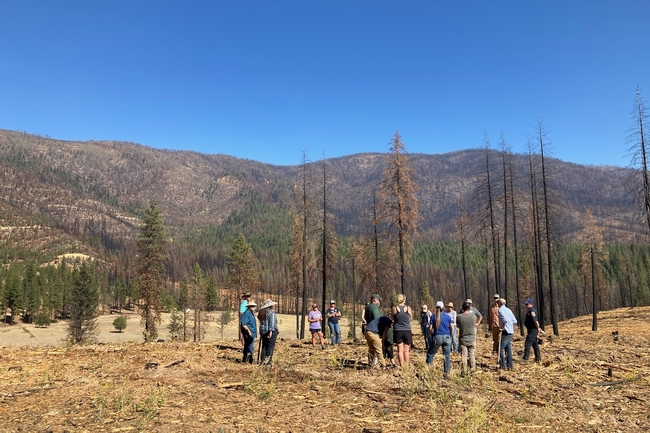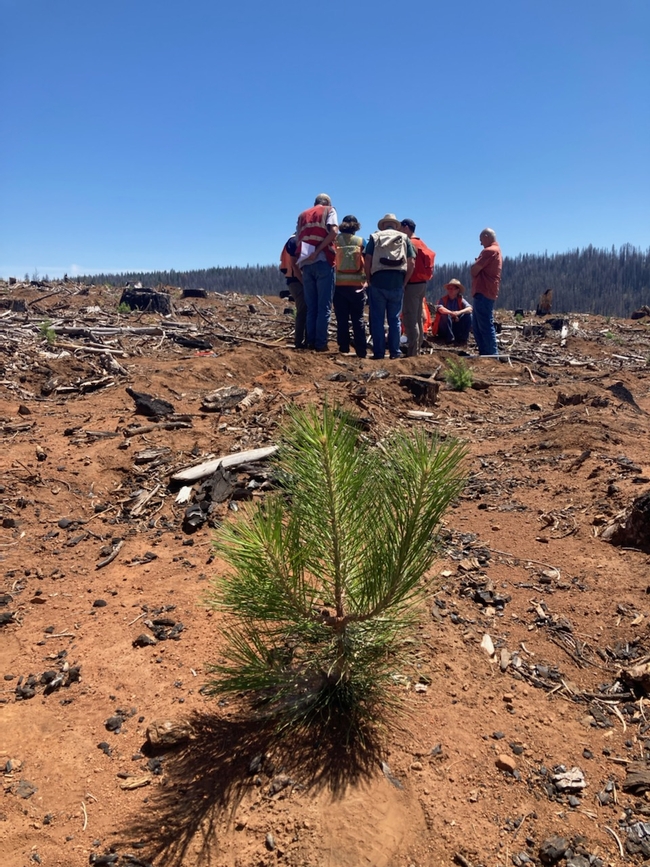Posts Tagged: reforestation
New California Agriculture article highlights effects of prescribed fire on young Sierra Nevada Mixed-Conifers
California's forests have long been adapted to fire, where the presence of regular, low-severity fires helped maintain forest health. After decades of fire suppression, many private forest landowners are interested in reintroducing fire to their...
UCCE report: Local forest restoration teams effective at rapid response
Quickly planting trees after wildfires crucial for communities, ecosystems, carbon goals
As the climate crisis fuels more high-severity wildfires, many forests – adapted to bounce back from frequent but less-intense fires – are struggling to recover quickly.
“In a lot of locations, forests in the Sierra Nevada that burn at high severity are not regenerating on their own,” said Susie Kocher, University of California Cooperative Extension forestry and natural resources advisor for the Central Sierra. “They need to have living trees to drop seeds; if everything dies in an intense fire, then there's a high likelihood in those locations that trees might not return for a while.”
According to Kocher, a forest may take multiple decades to grow back on its own, seeding in very slowly from the edges of a burn. To speed up that regeneration process, a pilot program of local “Emergency Forest Restoration Teams,” or EFRTs, have been helping forest landowners rapidly remove dead trees, plant new seedlings and expedite other vital tasks after wildfires.
Kocher is a co-author of a recently released report evaluating the EFRTs, which appear to be effective in assisting often-overwhelmed private landowners navigate competitive funding programs and complicated permitting pathways after wildfire. Small private landowners in California own 7 million acres, comprising 22% of forested land across the state.
“None of our current assistance programs were really designed to rapidly respond to high-severity fire disasters,” Kocher said. “And we're just getting so much more high-severity fire now that there needed to be a different way of helping people, besides business as usual.”
Lead agencies improve coordination of restoration efforts
Drawing from a successful model in Washington, Kocher and other members of the Governor's Forest Management Task Force recommended the formation of EFRTs in 2019 and this recommendation made it into the California Wildfire and Forest Resilience Action Plan of 2021.
Following the Caldor, Dixie and Tamarack fires during that year, disaster relief funds from CAL FIRE and the U.S. Forest Service enabled the establishment of pilot EFRTs in each of the affected regions. A key innovation was designating a local lead agency to coordinate restoration efforts: the El Dorado Resource Conservation District (Caldor), the Feather River Resource Conservation District (Dixie) and Alpine County (Tamarack).
“The idea is that one well-established local agency gets the funds to carry out all the reforestation work,” Kocher said. “They find contractors for the landowners and plan and carry out all the work needed, including dead tree removal, site preparation and replanting; this helps it be more coordinated across the landscape and reduces competition for contractors.”
“Also, for most of that work, there's no cost to the landowner – which is a huge benefit to them, because these things can get really expensive, like many thousands of dollars an acre,” Kocher added.
Although there was an initial steep learning curve for the local lead agencies on the complexities of reforestation and the maze of required permits, they quickly executed a significant number of forest restoration treatments. Within two years, the three pilot teams had collectively completed over 2,500 acres of dead tree removal and 1,400 acres of conifer planting.
“The overwhelming benefit of the pilots was that a lot of work got done on the ground, that otherwise would not have been done – at least not in the timeframe that was made possible by the EFRTs,” said Daylin Wade, a UCCE staff research associate and co-author of the recent report, who synthesized feedback from interviews of professionals involved in the program.
Rapid reforestation better financially, ecologically
Both Wade and Kocher underscored how the EFRTs were crucial in completing restoration tasks in a timely manner. Removal of dead wood becomes trickier and more expensive over time, as the trees decay and are dangerous to cut down.
“A major accomplishment was getting trees out of there while it was both safe and economically viable to remove those trees – and getting trees in the ground before shrubs dominate the site,” Wade explained.
It's also imperative to quickly remove the dead trees to reduce the fuel load and minimize the chances of re-burn in the area.
“If you're not doing this work, then you're actually endangering the investment that you're putting into rebuilding communities that burned, because they're in danger of burning again if you have huge piles of dead trees everywhere,” Kocher said.
Furthermore, expediting those tasks helps restore the forest cover that is crucial for sequestering carbon and achieving the goals of California's sweeping climate action plan – such as attaining carbon neutrality by 2045.
“We have very ambitious carbon goals for our forests in California, and so reestablishing them – even on private lands – is a public benefit,” Kocher said.
Evaluation of EFRTs by UC Cooperative Extension continues
In addition to enumerating the progress of the three EFRT case studies, the evaluation report also lists recommendations to further enhance the program, such as securing rapid and flexible funding for future EFRTs, improving guidance for local lead agencies and streamlining permitting processes.
The authors also stressed the need to expand opportunities for the commercial sale of woody material in the aftermath of a wildfire event. Selling logs and wood chips reduces the volume of material that would need to processed onsite by the EFRTs and their contractors, thereby defraying some of the costs for that work.
But there simply hasn't been a sufficient market for that woody biomass.
“It's a big barrier,” Kocher said. “If we had a healthier timber market, it would be easier to make this stuff pay its own way and be less of a subsidized endeavor.”
UC Cooperative Extension's EFRT evaluation work – made possible by funding from the U.S. Forest Service State, Private and Tribal Forestry, Region 5 – will continue for the next couple years. On the heels of this first report, Wade will next gather and summarize feedback from private landowners on whether the EFRTs are meeting their goals.
And, later this summer and fall, researchers will begin assessing the ecological success of the plantings in the restoration areas, surveying seedling survival and gauging the volume of competing vegetation.
“It's hugely encouraging that we've gotten all these trees in the ground, but it's not the end of the process – it's just the beginning,” Kocher said. “Trees and forests need to be maintained over time, so this next step will let us see how successful that has been, and if there are additional steps needed to actually ensure that these trees succeed and thrive.”
The full report, dedicated to the memory of report co-author and UCCE advisor Ryan Tompkins, can be found at https://ucanr.edu/efrt.
Lawn-pocalypse! Surviving Drought
Ah, summer! The season of sunburns, pool parties, and… lawn droughts. If your once lush, green carpet now looks like a crunchy brown doormat, you're not alone. Let's dive into why your yard is staging a dramatic death scene and what you can do to...

Bermuda grass and weeds overtaking drought stressed turf grass.
UC ANR Forest Research and Outreach Combines the Virtual and In-Person for Reforestation Education
Last month, the UC ANR Forest Stewardship program hosted a presentation in collaboration with California American Forests, CALFIRE, and the U.S Forest Service concerning reforestation efforts throughout the state. Below are key takeaways from the May...
Climate-Change Resources
University of California UC ANR Green Blog (Climate Change and Other Topics) https://ucanr.edu/blogs/Green/index.cfm?tagname=climate%20change (full index)
Examples:
- Save Trees First: Tips to Keep Them Alive Under Drought https://ucanr.edu/b/~CdD
- Landscaping with Fire Exposure in Mind: https://ucanr.edu/b/~G4D
- Cities in California Inland Areas Must Make Street Tree Changes to adapt to Future Climate https://ucanr.edu/b/~oF7
Drought, Climate Change and California Water Management Ted Grantham, UC Cooperative Extension specialist (23 minutes) https://youtu.be/dlimj75Wn9Q
Climate Variability and Change: Trends and Impacts on CA Agriculture Tapan Pathak, UC Cooperative Extension specialist (24 minutes) https://youtu.be/bIHI0yqqQJc
California Institute for Water Resources (links to blogs, talks, podcasts, water experts, etc.) https://ciwr.ucanr.edu/California_Drought_Expertise/
UC ANR Wildfire Resources (publications, videos, etc.) https://ucanr.edu/News/For_the_media/Press_kits/Wildfire/ (main website)
-UC ANR Fire Resources and Information https://ucanr.edu/sites/fire/ (main website)
-Preparing Home Landscaping https://ucanr.edu/sites/fire/Prepare/Landscaping/
UC ANR Free Publications https://anrcatalog.ucanr.edu/ (main website)
- Benefits of Plants to Humans and Urban Ecosystems: https://anrcatalog.ucanr.edu/pdf/8726.pdf
-Keeping Plants Alive Under Drought and Water Restrictions (English version) https://anrcatalog.ucanr.edu/pdf/8553.pdf
(Spanish version) https://anrcatalog.ucanr.edu/pdf/8628.pdf
- Use of Graywater in Urban Landscapes https://anrcatalog.ucanr.edu/pdf/8536.pdf
- Sustainable Landscaping in California https://anrcatalog.ucanr.edu/pdf/8504.pdf
Other (Non-UC) Climate Change Resources
Urban Forests and Climate Change. Urban forests play an important role in climate change mitigation and adaptation. Active stewardship of a community's forestry assets can strengthen local resilience to climate change while creating more sustainable and desirable places to live. https://www.fs.usda.gov/ccrc/topics/urban-forests
Examining the Viability of Planting Trees to Mitigate Climate Change (plausible at the forest level) https://climate.nasa.gov/news/2927/examining-the-viability-of-planting-trees-to-help-mitigate-climate-change/
Reports and other information resources coordinated under the auspices of the United Nations and produced through the collaboration of thousands of international scientists to provide a clear and up to date view of the current state of scientific knowledge relevant to climate change. United Nations Climate Action
Scientific reports, programs, action movements and events related to climate change. National Center for Atmospheric Research (National Science Foundation)
Find useful reports, program information and other documents resulting from federally funded research and development into the behavior of the atmosphere and related physical, biological and social systems. Search and find climate data from prehistory through to an hour ago in the world's largest climate data archive. (Formerly the "Climatic Data Center") National Centers for Environmental Information (NOAA)
Think tank providing information, analysis, policy and solution development for addressing climate change and energy issues (formerly known as the: "Pew Center on Global Climate Change"). Center for Climate & Energy Solutions (C2ES)
Mapping Resilience: A Blueprint for Thriving in the Face of Climate Disaster. The Climate Adaptation Knowledge Exchange (CAKE) was launched in July 2010 and is managed by EcoAdapt, a non-profit with a singular mission: to create a robust future in the face of climate change by bringing together diverse players to reshape planning and management in response to rapid climate change. https://www.cakex.org/documents/mapping-resilience-blueprint-thriving-face-climate-disaster
Cal-Adapt provides a way to explore peer-reviewed data that portrays how climate change might affect California at the state and local level. We make this data available through downloads, visualizations, and the Cal-Adapt API for your research, outreach, and adaptation planning needs. Cal-Adapt is a collaboration between state agency funding programs, university and private sector researchers https://cal-adapt.org/
Find reports, maps, data and other resources produced through a confederation of the research arms of 13 Federal departments and agencies that carry out research and develop and maintain capabilities that support the Nation's response to global change. Global Change (U.S. Global Change Research Program)
The Pacific Institute is a global water think tank that combines science-based thought leadership with active outreach to influence local, national, and international efforts to develop sustainable water policies. https://pacinst.org/our-approach/
Making equity real in climate adaptation and community resilience policies and programs: a guidebook. https://greenlining.org/publications/2019/making-equity-real-in-climate-adaption-and-community-resilience-policies-and-programs-a-guidebook/
Quarterly CA Climate Updates and CA Drought Monitor Maps (updated each Thursday) https://www.drought.gov/documents/quarterly-climate-impacts-and-outlook-western-region-june-2022



